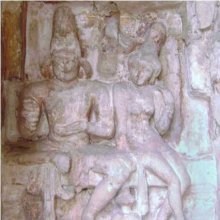Umasahitamurti, Umāsahitamūrti, Umasahita-murti: 5 definitions
Introduction:
Umasahitamurti means something in Hinduism, Sanskrit. If you want to know the exact meaning, history, etymology or English translation of this term then check out the descriptions on this page. Add your comment or reference to a book if you want to contribute to this summary article.
Images (photo gallery)
In Hinduism
Shilpashastra (iconography)
Source: Wisdom Library: Śilpa-śāstraUmāsahitamūrti (उमासहितमूर्ति) refers to a class of candraśekharamūti, which is an image (mūrti) which has candra (moon) as its head-ornament. These type of mūrtis are usually found in most important Śiva temples throughout South-India.The term is used throughout Śilpaśāstra literature.
Source: Google Books: Elements of Hindu iconographyUmāsahitamūrti (उमासहितमूर्ति).—The second variety of Candraśekharamūrti;—If the image of Candraśekhara has that of the Devī by his side, either on the same pedestal (pīṭha) or a different one, it is said to be Umāsahita-mūrti, or Candraśekhara with Umā.
Source: Archaeological Survey of India: Śaiva monuments at Paṭṭadakal (śilpa)Umāsahitamūrti (उमासहितमूर्ति) is found as a sculpture on the exterior (southern wall) of the temple of Trailokyeśvara.—Both, Umā and Śaṅkara (Śiva) are in standing pose. God’s left foot has a slight bend whereas the goddess is in samapāda or samanakha. He holds her tenderly with both his left hands. The lower one encircles her waist and the upper touches gently her chignon. There is a snake in his right upper hand and the lower rests on his thigh. He is kirīṭī but the tiara looks like a kulāyi of some of the sculptures in Viṭhala temple at Hampi-Vijayanagara.

Shilpashastra (शिल्पशास्त्र, śilpaśāstra) represents the ancient Indian science (shastra) of creative arts (shilpa) such as sculpture, iconography and painting. Closely related to Vastushastra (architecture), they often share the same literature.
Vastushastra (architecture)
Source: Shodhganga: Temples of Salem region Up to 1336 ADUmāsahitamūrti (उमासहितमूर्ति) carved attached to the shaft of a bhadraka pillar, is a life size sculpture of Śiva and Pārvatī standing side by side and gently embracing each other by their left and right hands respectively. This form of Śiva is also called by the name Āliṅganacandraśekharamūrti. Śiva holds in his right hands the paraśu and mṛga. His left hands are holding Umā. Lower left hand is embracing Umā’s waist, while his upper left hand is placed on her left shoulder. Umā is two handed and holds a lotus in her left hand and her right hand is placed embracing Śiva’s waist.

Vastushastra (वास्तुशास्त्र, vāstuśāstra) refers to the ancient Indian science (shastra) of architecture (vastu), dealing with topics such architecture, sculpture, town-building, fort building and various other constructions. Vastu also deals with the philosophy of the architectural relation with the cosmic universe.
Shaivism (Shaiva philosophy)
Source: Shodhganga: Iconographical representations of ŚivaUmāsahitamūrti (उमासहितमूर्ति) or simply Umāsahita refers to one of the twenty-three forms (mūrti) of Śiva mentioned in the Pūrvakāmikāgama (pratimālakṣaṇavidhi-paṭala): first and foremost among the Mūlāgama. The forms of Śiva (e.g., Umāsahita-mūrti) are established through a process known as Sādākhya, described as a five-fold process of creation.

Shaiva (शैव, śaiva) or Shaivism (śaivism) represents a tradition of Hinduism worshiping Shiva as the supreme being. Closely related to Shaktism, Shaiva literature includes a range of scriptures, including Tantras, while the root of this tradition may be traced back to the ancient Vedas.
See also (Relevant definitions)
Partial matches: Umasahita, Murti.
Full-text: Umasahita, Candrashekharamuti, Mahesha.
Relevant text
Search found 2 books and stories containing Umasahitamurti, Umāsahitamūrti, Umasahita-murti, Umāsahita-mūrti; (plurals include: Umasahitamurtis, Umāsahitamūrtis, murtis, mūrtis). You can also click to the full overview containing English textual excerpts. Below are direct links for the most relevant articles:
The Religion and Philosophy of Tevaram (Thevaram) (by M. A. Dorai Rangaswamy)
Chapter 1.3 - Umabhaga-murti (depiction of the Mother Goddess) < [Volume 2 - Nampi Arurar and Mythology]
Pallava period (Social and Cultural History) (by S. Krishnamurthy)
Nayanmars during the Pallava period < [Chapter 3 - Socio-Religious Life]
Status of Women < [Chapter 3 - Socio-Religious Life]
The Ruling elite < [Chapter 3 - Socio-Religious Life]
Related products
